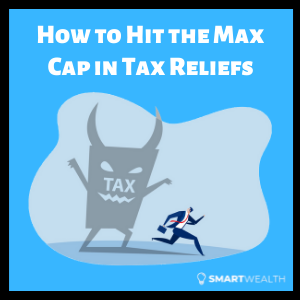Did you know that income tax reliefs have been capped at $80,000 since 2018?
If you noticed this, did you also wonder about these two things:
- How much income do you need to earn to be affected by this regulation, and
- How can you maximise and ensure you get the full tax relief?
Let’s find out the answers to these questions now!
Income Earners Who Are Affected
The Inland Revenue Authority of Singapore (IRAS) provides a breakdown of the income tax rate for all chargeable income.
Tax reliefs reduce your chargeable income. Therefore, it’s wise to qualify for more tax reliefs, as long as it doesn’t put a strain on your finances. With the rising cost of living in Singapore, saving even $1,000-$2,000 on tax can make a difference in reducing our stress levels.
Having said that, the cap of $80,000 in personal income tax reliefs will only affect you as long as you earn more than $100,000 per annum. This includes all other chargeable income, such as rental income and other side hustles.
Why $100,000? When you’ve hit the maximum of $80,000 in reliefs, your chargeable income will then be $20,000, which doesn’t incur any income tax.
So how can you make use of the tax reliefs made available to you?
SIDE NOTE When was the last time you conducted thorough financial planning or reviewed your finances? In this day and age in Singapore, doing so will absolutely improve the quality of life for you and your loved ones. Here are 5 reasons why financial planning is so important.
Maximising Tax Reliefs
In my previous article, I summarised the different types of tax reliefs available for all Singaporeans.
Let’s assume that two Singaporeans, David (single male), and Sarah (working mother of 2 children) are both earning $100,000 per annum.
What’s the maximum amount of tax reliefs they can get?
Scenario 1: David
David is a 35-year old single male employed in Singapore. He lives with and supports his elderly parents. According to his profile, he is eligible for the following tax reliefs:
- Earned Income Relief
- CPF Relief
- Parent Relief
- NSman Relief
- Course Fee Relief
- CPF Cash Top-up
- SRS Relief
| Tax Relief Type | Tax Relief Amount |
| Earned Income Relief | $1,000 |
| CPF Relief (20% x $100,000; disregarding the distinction between Ordinary Wages and Additional Wages) | $20,000 |
| CPF Relief – Voluntary Medisave Contribution (capped at $37,740-$37,000; and still far from hitting the BHS) | $740 |
| Parent Relief (for 2 parents) | $18,000 |
| NSman Relief (did reservist that year; KAH gets $5,000) | $3,000 |
| Course Fee Relief (maximum) | $5,500 |
| CPF Cash Top-up (maximum, $14,000) | $14,000 |
| Total | $62,240 |
For this scenario, I left out the life insurance relief (which most people can’t claim) and the handicapped brother/sister relief.
If David decides to use the above tax reliefs at his disposal, without doing the SRS relief, he will only qualify for a tax relief amount of $62,240. This means that the amount of $37,760 ($100,000-$62,240) will still be taxed. According to the gross tax payable from IRAS, David will still have to pay $200 + (3.5% x $7,760) = $471.60 for the year of assessment.
If he wants to maximise the amount of tax relief he can claim ($80,000), he will have to make a cash contribution of $15,300 (maximum for Singapore citizens and PRs) to his Supplementary Retirement Scheme (SRS) account. Doing so will push up his total tax reliefs to $77,540.
However, he will not be able to withdraw from his SRS account until he is 62 years old (current statutory retirement age), unless he doesn’t mind paying a 5% penalty to withdraw early.
He could put in $7,760 to his SRS account to avoid the additional 3.5% tax (after the first $30,000), so that the chargeable income will only be $30,000. This will reduce the tax he needs to pay to only $200. However, it really is only $271.60 of tax savings, compared to having to put in $7,760 in his SRS.
Alternatively, David can also consider donating to an approved charity to qualify for tax deductions from donations. From 2014-2021, the government released an incentive for Singaporeans to donate to approved charities. If you donate, you will get a 250% tax deduction on the amount you donated that year. Given that David believes it is better to donate the money he would have paid on tax, he donates $7,104 to the charity of his choice (see the list of approved donations here). This qualifies him for an additional $17,760 in tax deduction and thus does not have to pay for tax for the Year of Assessment.
For most single males, it’s very unlikely you’ll able to hit the maximum cap of $80,000 in reliefs.
DID YOU KNOW? According to a survey conducted by MoneySense, about 3 out of 10 Singapore residents aged 30 to 59 had not started planning for their future financial needs. This isn't surprising because personal finance can seem complicated and daunting. But really, there are only a few things that you should focus on. Learn how to significantly improve your personal finances with the 7-step "wedding cake" strategy today.
What if David gets married and have children?
If you were to get married, more tax reliefs will open up. Here are a few:
| Tax Relief Type | Tax Relief Amount |
| NSman Parent Relief | $750 (max) |
| Qualifying Child Relief | $4,000 per child ($7,500 if handicapped) |
| Spouse Relief | $2,000 ($5,500 if handicapped) |
Even so, because conditions have to be satisfied, males who are single or married, will find it difficult to reach the cap.
Scenario 2: Sarah
As the tax reliefs eligible for a single female are similar to the single male (less the NSman Relief), there’s no point touching on it again. Instead, let’s look at the reliefs for working mothers.
Sarah is a 40-year old working mother of 2 children (below 12 years old). She lives with her elderly parents, who are involved in looking after her children. She also employed a helper to assist her in caregiving and household chores. According to her profile, she is eligible for the following tax reliefs:
- Earned Income Relief
- CPF Relief
- Parent Relief
- NSman-related Relief
- Child Relief
- Working Mother Child Relief
- Foreign Domestic Worker Levy Relief
- Grandparent Caregiver Relief
- Spouse Relief
- Course Fee Relief
- CPF Cash Top-up
- SRS Relief
Compared to male taxpayers, females have the Working Mother Child Relief (WMCR), which is likely to contribute the highest amount of reliefs, especially when they are earning a high income and have many children.
| Child Order | WMCR Amount |
| 1st | 15% of mother’s earned income |
| 2nd | 20% of mother’s earned income |
| 3rd and beyond | 25% of mother’s earned income |
Here’s the scenario for Sarah:
| Tax Relief Type | Tax Relief Amount |
| Earned Income Relief | $1,000 |
| CPF Relief (20% x $100,000; disregarding the distinction between Ordinary Wages and Additional Wages) | $20,000 |
| CPF Relief – Voluntary Medisave Contribution (capped at $37,740-$37,000; and still far from hitting the BHS) | $740 |
| NSman Wife Relief | $750 |
| Qualifying Child Relief ($4,000 per child) | $8,000 |
| Working Mother Child Relief | 1st child (15%) – $15,000; 2nd child (20%) – $20,000 |
| Parent Relief (for 2 parents) | $18,000 |
| Total | $83,490 |
From the above, Sarah has already qualified for $83,490 in reliefs, exceeding the cap of $80,000. Given this computation, Sarah is able to reduce her chargeable income to $20,000 – and will not have to pay tax for that year.
Furthermore, there are other reliefs she can still claim:
| Tax Relief Type | Tax Relief Amount |
| Foreign Domestic Worker Levy Relief (concessionary rate) | $1,440 |
| Grandparent Caregiver Relief | $3,000 |
| Course Fee Relief (maximum) | $5,500 |
| CPF Cash Top-up (maximum) | $14,000 |
| Spouse Relief | $2,000 ($5,500 if handicapped) |
| NSman Parent Relief | $750 |
| SRS Relief | $15,300 (max) |
A common question: “should I contribute to SRS once I hit the cap?”
There’s no real tax benefit that comes from contributing to SRS once you’ve hit $80,000 in reliefs. In fact, there are disadvantages in doing so. Here are some of them:
- The contribution doesn’t reduce your chargeable income anymore
- There’s a 5% penalty if you withdraw before the statutory retirement age (and 100% of withdrawn amount is taxable)
- Even after the retirement age, 50% of the withdrawn amount is taxable
- Investments available for SRS funds are not as wide as cash investments
If Sarah has too many reliefs to claim, she should let her husband claim some of the reliefs which are shareable such as the Qualifying Child Relief, so as to not let them go to waste.
What if Sarah has a 3rd child?
As Singapore hopes to encourage more families to have children, the working mother’s child relief for the 3rd child and beyond is 25% of the mother’s earned income. Thus, the WMCR can be the biggest contributor to total reliefs.
To hit the maximum cap, let’s see how much income and the number of children one needs to have:
| Mother A | Mother B | Mother C | Mother D | |
| Income | 334,000 | 168,000 | 99,000 | 76,000 |
| Tax Reliefs: | ||||
| Earned Income Relief | 1,000 | 1,000 | 1,000 | 1,000 |
| CPF Relief (disregarding the distinction between OW and AW) | 20,400 | 20,400 | 19,800 | 15,200 |
| Working Mother Child Relief | ||||
| – 1st Child (15%) | 50,000* | 25,200 | 14,850 | 11,400 |
| – 2nd Child (20%) | – | 33,600 | 19,800 | 15,200 |
| – 3rd Child (25%) | – | – | 24,750 | 19,000 |
| – 4th Child (25%) | – | – | – | 19,000 |
| Total | 71,400 | 80,200 | 80,200 | 80,800 |
Want to Maximise the Total Cap? Have More Children!
So if you want to maximise the total tax relief that the government gives, here are some of the “best practices”:
- Have more than 2 children
- Be a working mother
- Involve your parents/parents-in-law with caregiving
- Help to support your parents financially
Need help with other financial matters? Consider going through a comprehensive financial planning session with us.


